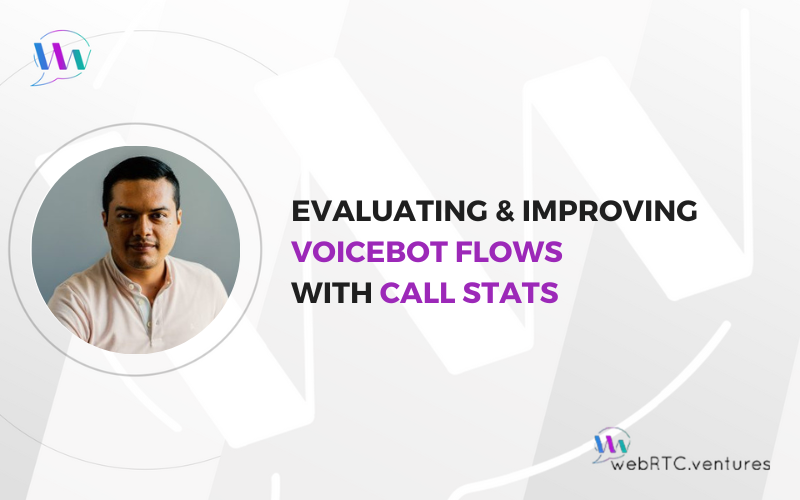Voicebots offer efficient resolution of common customer inquiries, making them an indispensable component of today’s customer service flows. In previous posts, we have seen how you enhance the capabilities of voicebots using the power of LLMs and also integrate such capabilities in a web interface using WebRTC, allowing you to empower your customer service agents with AI-powered real-time in-call and post-call assistance.
In order to optimize the performance of bot flows, it’s important to have visibility over them. In this post, we explore using call statistics to refine these processes dynamically by tailoring the interactions, streamline processes and ultimately, enhancing customer experience. We’ll also cover the tools one can use to implement call stats.
Understanding Call Stats
Integrating AI Agents or AI Agent Assist (co-pilots) into a contact center application is complex, with many moving parts that usually include a Public Switched Telephone Network (PSTN) provider connected to a real-time communication gateway, which in turn provides integration of the call within their application. Even with the use of great SaaS solutions such as Amazon Connect that offer cloud-based contact center service in an straightforward manner and that provide a simpler integration with other third-party services such as Symbl.ai for advanced AI capabilities, there is always unavoidable complexity in the picture.
Being that things can go wrong at any point of the architecture, companies need to have visibility to know where issues arise and for generally improving the flow overall. Call statistics provide such visibility by giving a health indication of the complete process. They slice the customer journey to get their needs met, either by the bot or by a human agent.
Call stats can track a great deal of data about virtual agent interactions, including:
- Total minutes customers speak with the bot
- List of the most common inquiries asked of the bot
- Number of customer inquiries that were satisfied by the bot
- Number of customer inquiries that required transfer to a human agent
- and more
Call Stats Benefits and Challenges
Having call stats implemented in an application provides multiple benefits, among which we find:
- Enhanced user experience. Stats provides a clear view of the events that happen during a call. Such data is used to evaluate the responses and tailor these to enhance customers’ experience.
- Improved efficiency. Recording the events identifies bottlenecks that could impact user experience, and allows the implementation of solutions to overcome them.
- Data-driven decision-making. Stats provide insights that can be used to refine voicebot capabilities and strategize best-in-service strategies for the organization.
That being said, adding stats also implies challenges. These will depend on the overall architecture, but some generic ones are:
- Data storage. Metrics and stats need to be stored somewhere before being consumed. It’s important to select the right tool for your use case, and in many cases, this ends up adding another node to maintain.
- Metrics dashboard. The dashboard where to visualize the data is as important as the data itself. Same as with storage, you need to select the right tool and maintain it.
Tools to Implement Call Stats
How you implement call stats will depend on how the voicebot itself is implemented. For example, in an on-premise scenario that can take advantage of open source alternatives such as FreeSwitch for integration with PSTN and JavaESL for defining the business logic of the integration, the latter is the perfect place for adding additional logic that collects the information your application needs to record.
The other important element is storage of the data. For small amounts of data, simple solutions such as MongoDB can provide the required capabilities. While for bigger amounts it will be required the use of more specialized tools such as OpenSearch.
Other scenarios where cloud-based solutions such as Amazon Connect are involved can take advantage of the compatibility with other cloud services such as AWS Cloudwatch and Amazon OpenSearch to build powerful storage and visualization tools.

Improving the Inspectability of Voicebot Flow
Adding call stats and metrics to the bot flow allows companies to gain visibility of the performance of the bot, bottlenecks in the process, and potential improvements. These provide useful information that can be used to improve user experience and build a better brand reputation.
In a future post, we will take a more technical approach on this and look at the details of implementing call stats in a voicebot flow based on open source tools, FreeSwitch, for connecting PSTN providers with our Contact Center application, and MongoDB for storing such stats.
If you’re looking into improving the flow of your virtual agent or implementing a voicebot from scratch, along with more LLM-powered features into your agent’s browser, we have the expertise you need! Contact WebRTC.ventures today, and let’s make it live!













